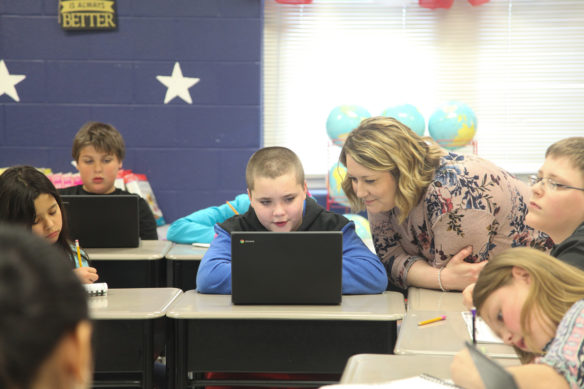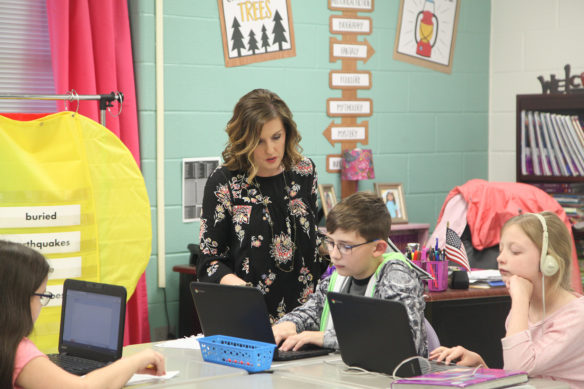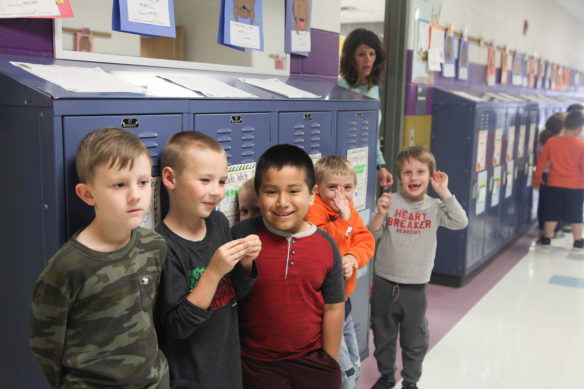
Jessica McPherson, the principal at Gamaliel Elementary School (Monroe County), takes a look at what student Danyel Combs is working on in a social studies class. Gamaliel Elementary was recently recognized by the National Association of ESEA State Program Administrators as a 2018 National ESEA Distinguished School for its work in significantly closing the achievement gap between student groups.
Photo by Megan Gross, April 8, 2019
- Gamaliel Elementary has been recognized by the National Association of ESEA State Program Administrators for its work in significantly closing the achievement gap.
- The school has a high population of students in poverty and a high transient population, but its teachers make an effort to get to know its students in order to help them achieve.
By Mike Marsee
mike.marsee@education.ky.gov
Failure is not an option at Gamaliel Elementary School.
There are some students at the Monroe County school who are performing at the Novice level, as there are at any school. And some of those students face challenges outside school that might contribute to that performance.
But none of them are allowed to stay at that level.
“It’s not an option. You don’t get to sit there and fail,” said Jaime Pare, a 5th-grade social studies teacher. “I tell students all the time, even when they’re doing independent work in my room, ‘You can’t sit there for the entire hour class period and fail. My job is to teach you. Raise that hand up and ask me a question.’”
Gamaliel Elementary has had success in novice reduction in large part because of the way the staff gets to know its students – both on a personal level and on an academic level.
The school was recognized earlier this year for its work in significantly closing the achievement gap between student groups by the National Association of ESEA State Program Administrators (NAESPA). Gamaliel is one of two Kentucky schools – along with Perryville Elementary School (Boyle County) – to be honored as a 2018 National ESEA Distinguished School.
Gamaliel Elementary’s Novice numbers have been low for some time.
“Around 15 years ago, curriculum work began in our district that became the foundation of where we are today,” said Jessica McPherson, the school’s principal. “This work guided instruction with the implementation of pacing guides and common assessments throughout the district.
Although the number of students scoring at the Novice level have been low, they’ve fallen even further as a result of the relationships they form with their students and a focus on data.
In 2013-2014, the Novice levels at Gamaliel were 5.4 percent overall and 5.9 percent for economically disadvantaged students in reading, and 3.8 percent overall and 4.9 percent of economically disadvantaged students in mathematics. In the 2017-2018 school year, 3.7 percent of the school’s student body and 3.4 percent of economically disadvantaged students were at the Novice level in reading, and 2.8 percent of its student body and 3.4 percent of economically disadvantaged students were at Novice in mathematics.
“I wouldn’t say that we intentionally focus on novice reduction. We have discussions regularly about ensuring that all students are showing growth regardless of their achievement level,” McPherson said. “If we focus on all students showing growth and providing them with the support they need to reach their highest potential, then the number of novice students automatically decreases.”
Gamaliel Elementary, located in a rural community about two miles from the Tennessee border, has both a significant population of students living in poverty – 77 percent of its students qualified for free or reduced-price meals last year – and a significant transient population.
“Some of our kids work hard to overcome obstacles at school and outside of our building, but we don’t let that stop us from pushing them,” McPherson said.
It’s a small school, with only 242 students in grades K-5, and one in which teachers make an effort get to know their students very well – even if they have only been there for a short time.

Amy Rouse, a teacher at Gamaliel Elementary School (Monroe County), works with student Jesse Coe in her 3rd-grade classroom. Rouse said faculty members take pride in getting to know students and their families to make sure each student’s needs are met.
Photo by Megan Gross, April 8, 2019
“We really take pride in making relationships with our students, learning them, their families, their backgrounds, and making sure their needs are being met,” said Amy Rouse, a 3rd-grade reading teacher who is in her 20th year at Gamaliel.
Greta Hale, a reading recovery and primary literacy teacher who is in her 29th year at Gamaliel, said that intimate knowledge helps the teachers help their students.
“The teachers know our kids. We know them as far as their home lives, we know their successes and their struggles. And when we find those struggles we work to help them overcome them,” Hale said.
That means making extensive use of interventions. McPherson said Gamaliel devotes a 50-minute class period daily to Response to Intervention (RtI). She said the school doesn’t have the staff to provide dedicated interventionists, so teachers at each grade level do their own interventions.
Pare said she has two RtI class periods per day in which students are placed into groups based on their needs. Students may work independently on those needs, while at the same time Pare is bringing small groups of them to a table for more focused instruction.
“It could be things that I’ve identified in my class, it could be things that other teachers have told me they need me to work on with this group. It could be things I’ve seen (in the programs they’re working on), but I’m constantly working with them to get better,” she said. “If I’m not working with a small group, I am hovering, going from student to student and trying to ask whatever questions I have during their independent work.”
Teachers use frequent formative assessments to determine what their students need.
“It’s automatically using that to guide your instruction, and you should keep revisiting that and revisit and revisit until those students are meeting those targets and those expectations,” said Shelly Buck, a 4th- and 5th-grade mathematics teacher.
For example, Buck said she will sometimes deviate from the lesson plan if she sees that students aren’t understanding a topic, waiting to move on until she’s sure they have grasped it.
Buck said students learn very quickly that their teachers expect success.
“They come to school and they know that we’re going to work,” she said. “When they come into the classroom, with our expectations being high, they know that they’re going to have to perform at our level and we’re not going to give up on them.”
Pare and other teachers post charts with color-coded stickers to help students track their progress from Novice to Apprentice to Proficient to Distinguished.
“They’re very competitive. They really notice it,” she said. “During RtI time we have charts on the board that show them what they still need to achieve. They know where they’re at, all of them. You could ask them, ‘What are some things you need to work on,’ and they could tell you.”

Students line up in a hallway at Gamaliel Elementary School, where one teacher said students at the school don’t have the option of staying at the Novice level. Another teacher said students learn very quickly that their teachers expect them to succeed.
Photo by Megan Gross, April 8, 2019
She said teachers know what their students need because of a data-oriented culture that starts with school administration.
“Our leadership for the past several years has been very data-oriented. They encourage us to dig into that data, and I’m someone who’s data-obsessed anyway,” Pare said. “That’s how you reduce novice: You have to realize who your novice kids are, exactly what they’re struggling in, and you try different strategies to help them improve. And then you test again and see, have they improved or do we need to work on something else.
“In my RtI class, that is a constant almost ballet of different things we’re doing all at one time to make sure each student is achieving that success from wherever they’re starting at.”
Tara Rodriguez, the director of the Division of School and Program Improvement at the Kentucky Department of Education and the secretary of the NAESPA board of directors, said Gamaliel Elementary is a success story on a number of levels.
“The staff at Gamaliel does many things well, like fostering a culture of high expectations, building relationships among staff and with families and community and meeting individual needs of students,” Rodriguez said. “Gamaliel exemplifies what it means to be a Distinguished school.”
MORE INFO …
Greta Hale greta.hale@monroe.kyschools.us
Jessica McPherson jessica.mcpherson@monroe.kyschools.us
Jaime Pare jaime.pare@monroe.kyschools.us
Amy Rouse amy.rouse@monroe.kyschools.us




Leave A Comment